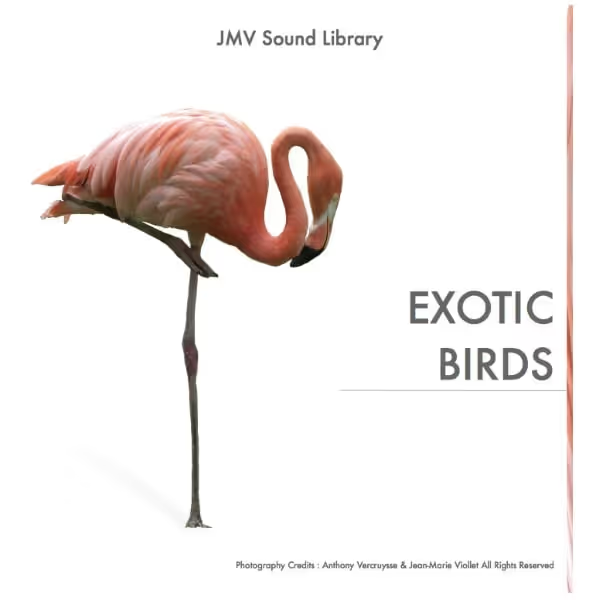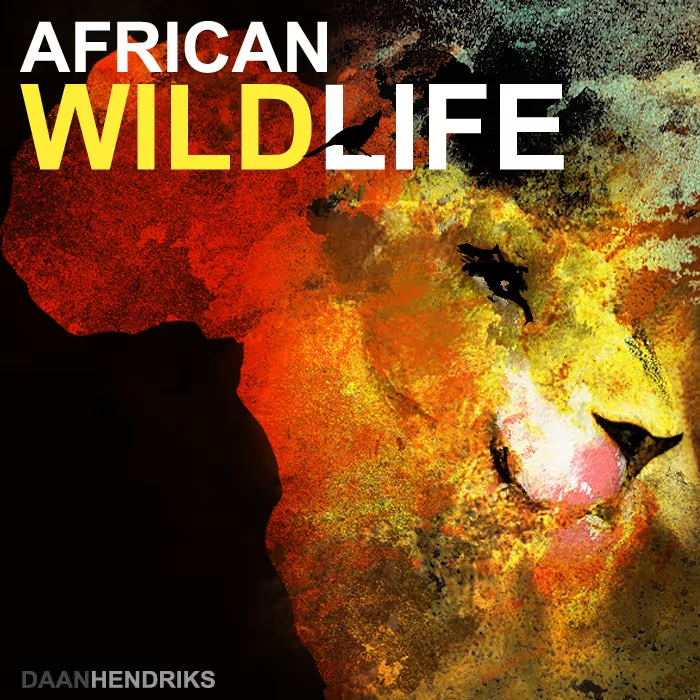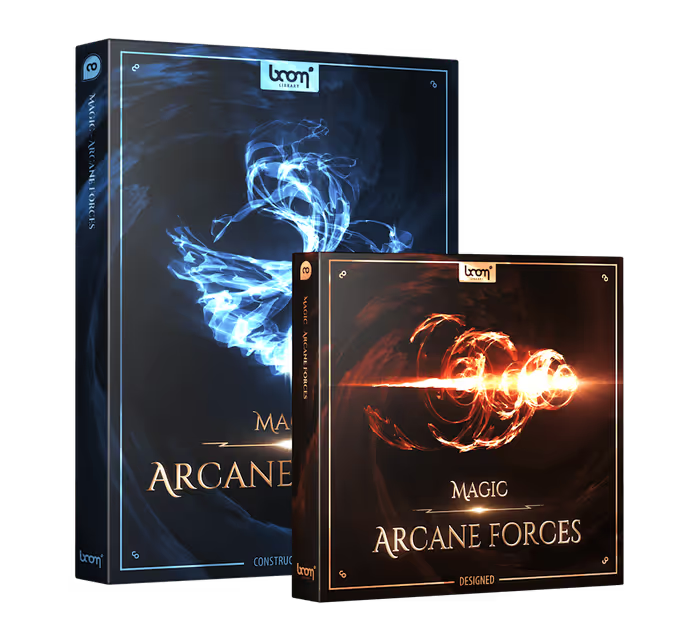Here, Audio Lead Elise Kates (who handled sound design and FMOD implementation) and Ambient Sound Designer Andy Martin talk about blazing their own sonic trail for the IP (and not having to follow what's already been done sound-wise), creating slimy and gross sounds for Zombies, designing dark magic elements, crafting immersive backgrounds in a 2D environment, using FMOD for implementation, and so much more!
Guybrush Threepwood, protagonist of the Moneky Island adventure game series, is back in Return to Monkey Island (developed by Terrible Toybox/published by Devolver Digital). Sound-wise, the narrative-driven game features sea shanty-style tunes (from composers Michael Land, Peter McConnell, and Clint Bajakian), fun, magical, and sometimes gross sound design elements created and implemented by Audio Lead/Sound Designer Elise Kates, and naturalistic and immersive backgrounds built by Andy Martin (Ambient sound designer).
Here, Kates and Martin talk about their fresh approach to the game’s sound which wasn’t limited to what’s already been done for the game series. Kates discusses her approach to sound design, making fun, colorful, and gross sounds that capture the lively spirit of the visuals. She talks about designing textural elements that enhance the music, dark magical effects for antagoinsit LeChuck, and squishy organic assets for the zombie characters. Martin talks about his opposite approach to the backgrounds, crafting natural, realistic ambiences that support the locations and give a sense of what’s happening in the world around Guybrush. They talk about implementation and using FMOD middleware, the technical challenges of making the game work on different platforms, and much more!
Return to Monkey Island gameplay reveal trailer
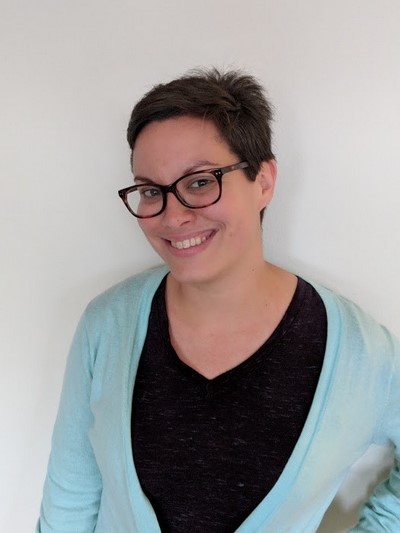
What were the game designers/director’s goals for sound on Return to Monkey Island? How did they want to build on what’s been done for this IP?
Elise Kates (EK): Going into it, I had pretty extensive conversations with Ron Gilbert and Dave Grossman about that. I was really lucky in that they pretty much gave me carte blanche to do whatever I felt was best in the situation.
…they pretty much gave me carte blanche to do whatever I felt was best in the situation.
In a lot of ways, I was starting from scratch. There were a couple of things early on that they wanted to try out as references to the other games, but by and large, once we got into the meat of the game, those weren’t very prominent and so this new opportunity opened up to let us do whatever we felt was best. That was really fun and freeing in a lot of ways. Surprisingly enough, I didn’t have to worry about sticking with any previous palette.
Andy Martin (AM): I have to second what Elise said. In my early conversations with Ron, it was very much the same. He was more interested in what I could bring to this new game as opposed to trying to hue too closely to the sounds that came before.
The only time there was a request to use something similar to the old games was for LeChuck’s ship. There were some sounds from the previous games that they asked me to work into the ambiences, but other than that, it was whatever we thought worked best.
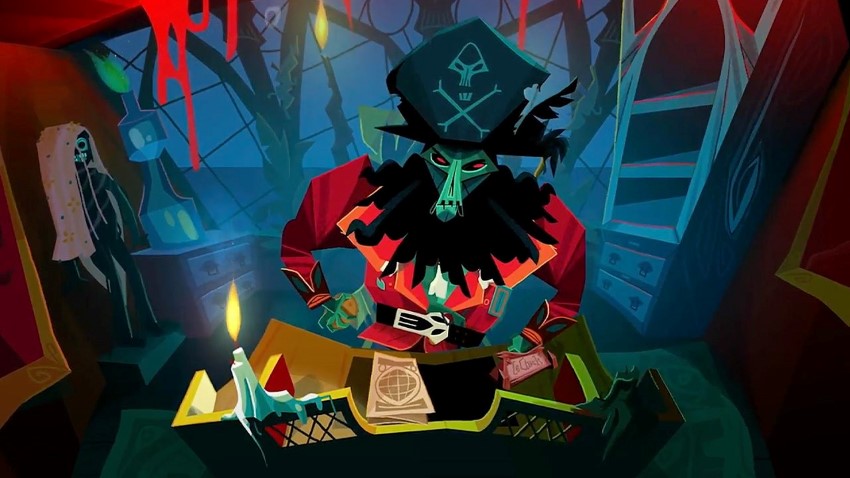
Looking at the art for the game and trying to come up with a general aesthetic and tone palette, what were some of your initial creative ideas for that? Did you collaborate on what that would sound like?
EK: Initially, to get the ball rolling, we broke the game down into zones. LeChuck’s ship was the first one that we worked on to get a palette and see what worked. Thankfully by the time I had started working on the sound, the art style was already established. Honestly, that helped to guide me because I saw how fun and unique that was. I really wanted to carry that feeling through the sound as well. I felt that if things were too gritty or realistic then they wouldn’t match the vibe of what we were seeing.
I focused on amping up the fun. There are a lot of gross elements in LeChuck’s ship – the slime, the soup, and squeezing through the porthole and everything. I had a lot of fun building up a gross palette of sounds to draw from throughout the game.
Also, there are some magical elements in that area too, like the ghost chickens.
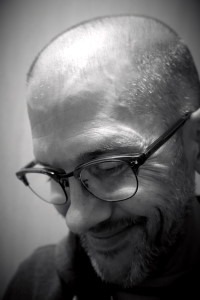
My approach was almost the exact opposite; I tried to be realistic…
So LeChuck’s ship was a great spot to get my gears turning. Because I had the opportunity to experiment, I was able to try out a lot of things in a way that normally I don’t get the opportunity to. I was lucky enough to find new ways of using tools that I thought I was familiar with in ways that turned out great here.
AM: I came onto the game a lot later than Elise did, so my inspiration came from a game that was in a more finished-looking state. My approach was almost the exact opposite; I tried to be realistic – to play the ambiences straight as a way of highlighting the goofiness that Elise or the story was trying to focus on.
Ron told to me early on that the ambiences should just live on their own while the game happens in front of them. So, I was much more setting-building than storytelling – with some exceptions for a few different zones, which we’ll talk about later on.
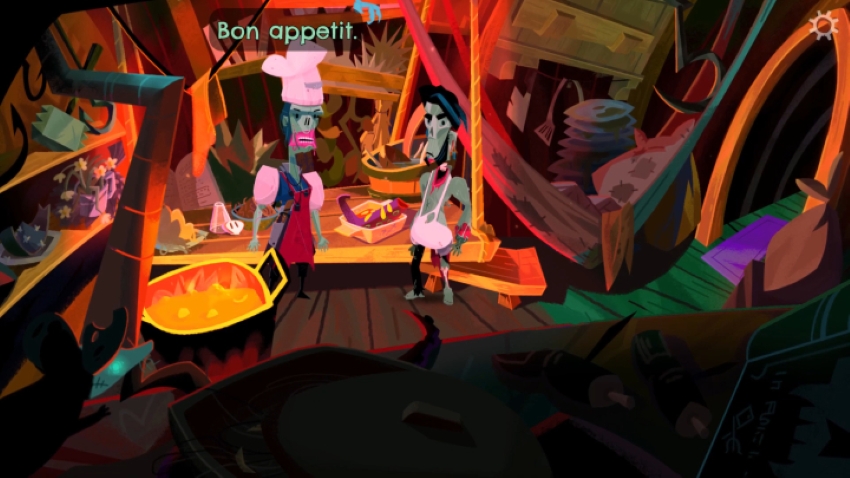
Return to Monkey Island is a narrative-driven game. What challenges did that pose for you in terms of sound design?
EK: We knew there was going to be so much dialogue in the game, so anything that we made had to live well in the mix between all the dialogue and the great music. The music is so dynamic and I definitely didn’t want to step on their toes either. That team did a wonderful job, obviously.
…nothing could be overly complex or heavy because the sound effects were going to have to float on top of everything else.
I knew everything needed to have a pop, to stand out on its own, but at the same time, nothing could be overly complex or heavy because the sound effects were going to have to float on top of everything else. We had to clearly communicate what was happening on the screen yet not be distracting to the player because the most important part of the game is the story.
[tweet_box]Making the Merry Sound of ‘Return to Monkey Island'[/tweet_box]
There were definitely times when I tried to turn it up to 11, but we realized in implementation that wasn’t the best way to work that into the moment.
Also, there are so many wonderful animations that only happen in one spot (that don’t happen often in the game and you have to trigger in really specific ways), so I would have to go through and play the game and make these really long lists. It was impossible sometimes for me to go through and pick stuff because all the animations were so great.
…we had a production timeline so I couldn’t make sounds for a million years…
But of course, we had a production timeline so I couldn’t make sounds for a million years – as much as I wanted to. Ron and Jenn [Sandercock, game producer] had to go through my ideas and pare them down and decide jointly what was a priority and what wasn’t. That was really helpful. As much as I wanted to keep making cool sounds, I had to take the key points from that decision-making process so I knew what needed to be hit every step of the way. That helped to inform my creative decisions too – for how I was going to make sounds and implement them.
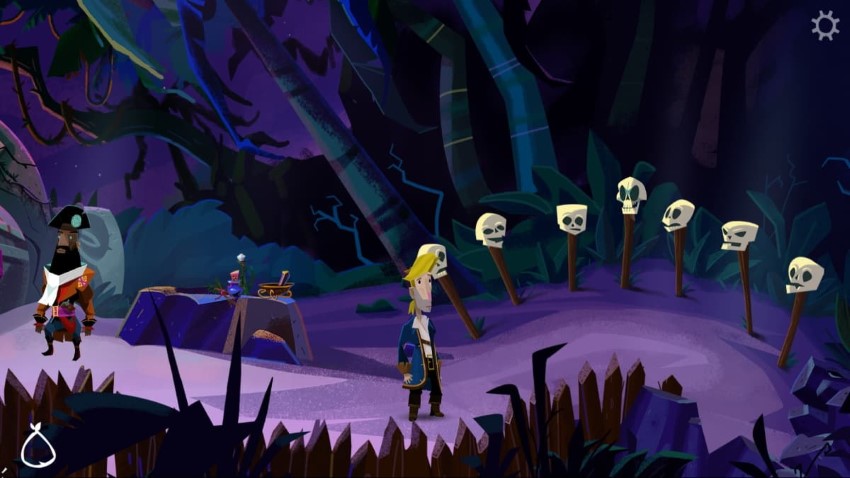
There was a fun interplay of sound design and music in Part III, during the ritual to make the map reveal its secrets. Guybrush has to set up the skulls in the right order and then bang on them to play LeChuck’s melody. Can you talk about what went into the sound for this part of the game? How you were able to collaborate with the music department to make all that feel really fluid?
EK: The music department knew what notes they wanted the skulls to hit when they were struck. There were a couple of different ideas about how they wanted to execute that but the singing was the coolest option so that’s what ended up in the game. I knew what those notes were going to be, so I made textural elements that could play underneath them to highlight the singing and what the music department was doing.
We had a lot of loopable assets because we didn’t want there to be any weird gaps in audio if the player needed to take a minute to figure out the puzzle.
The dark magic palette that I landed on was all pretty much made using Paul Stretch…
That cut scene is a great example of me finding new ways to use tools. The dark magic palette that I landed on was all pretty much made using Paul Stretch (Paul’s Extreme Sound Stretch), which is a free tool for creating textural elements. The magic textures were made from recordings of me moving a wicker basket, which I ran through Paul Stretch with the tonal settings turned up really high. That was the source for most of the magic sounds, but there are more obvious things too, like a singing bowl, and I really cranked up Paul Stretch on that. I also used a lot of Soundtoys plugins to make everything sound even spookier.
I also used some callbacks to sounds that I made for LeChuck’s ship as well because we established that LeChuck was using dark magic pretty early on. So some of the spooky palettes that I used in his office on the ship are also in the dark magic elements in this scene. That was a great opportunity for me to tie that all together.
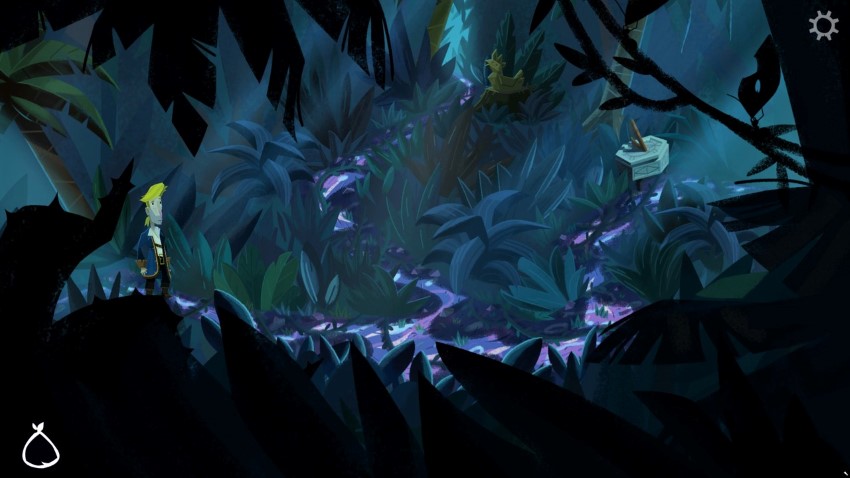
There are several islands in the game: Monkey Island, Mêlée Island, Brr Muda, Terror Island, Scurvy Island, and Barebones Island. Can you talk about some key characteristics of the ambiences on these islands?
AM: When I got started, we counted up all the different zones and rooms that we were going to have to work in, and I had a terrified moment of realizing just how much work that was going to be. Ron and I initially broke that down into the minimum set of places that needed distinct-sounding ambiences. Then Jenn stepped in and reminded us of the timeline that we needed to follow. She did a really good job of whipping us into shape over how much we actually reasonably thought we could get done.
Because I was following behind the established game production, there were a lot of places that I had nothing to plan to, so a lot of my work was very reactionary. I’d get to a new zone and be confronted with whatever was there. I tried to do whatever I could to make it not sound like anything that I’d used already.
…a lot of my work was very reactionary. I’d get to a new zone and be confronted with whatever was there.
The very first zone we started with was Brr Muda; it was our trial by ice, so to speak. I drew on my experience as a field recordist and my work on ambiences in the past. I tried to create an eco-type sonic palette that would blend with whatever that location was – a fauna that would exist in each location – while also hueing to that idea of each place sounding distinct.
 Tesla Model X 2015 electric full size crossover SUV sport utility vehicleKrampfstadt Studio65,00 $32,00 $51% OFF
Tesla Model X 2015 electric full size crossover SUV sport utility vehicleKrampfstadt Studio65,00 $32,00 $51% OFF
Everything that went into the ambiences was supposed to be something that was unseen. But, there was a very specific call out early on that the sounds in the ambiences couldn’t be too distinct because then they’d need to put something into the narrative about that. And if there was anything that they wanted to avoid, it was having to make the narrative even longer.
Everything that went into the ambiences was supposed to be something that was unseen.
Also, anything that was on-screen at any point couldn’t live in the ambiences because then the players would be accustomed to looking around for something that they had seen before.
Looking at Terror Island, I was thinking about what a dark jungle-y, twisty, windy path would feel like. I responded to that by looking at things like the flora (the plants) that were around. They were cartoony jungles, but they also had a feeling of creepiness and wetness to them. And the occasional fauna that you did see – like a lizard-thing or creepy insect-type thing – lent itself to using my recent recordings of frogs. But rather than have them be a constant, ribbiting background, I lowered the pitch and played them in groups that would swell in the distance and then come back.
…I had to dial the wind back a lot because Ron kept hearing it as the ocean in the distance.
When things were taking place deep inside wooded areas, like on Terror Island or on Melee Island, there was always an opportunity to work in some canopy wind that had a bit of a swish and sway up above everything else. But I had to dial the wind back a lot because Ron kept hearing it as the ocean in the distance. And since we were in the interior part of the island, we didn’t want it to sound like we were next to the beach. So, with a bit of sadness in my heart, I pulled that back.
The overall feel of every zone of each island was crafted in the moment because we were on a rapid schedule. So I’d start working on a zone, build up a palette that would fit, and if it started to feel like I was using any sounds that were reminiscent of another island, I’d find different ones. It was more about teasing each island away from the others than anything else.
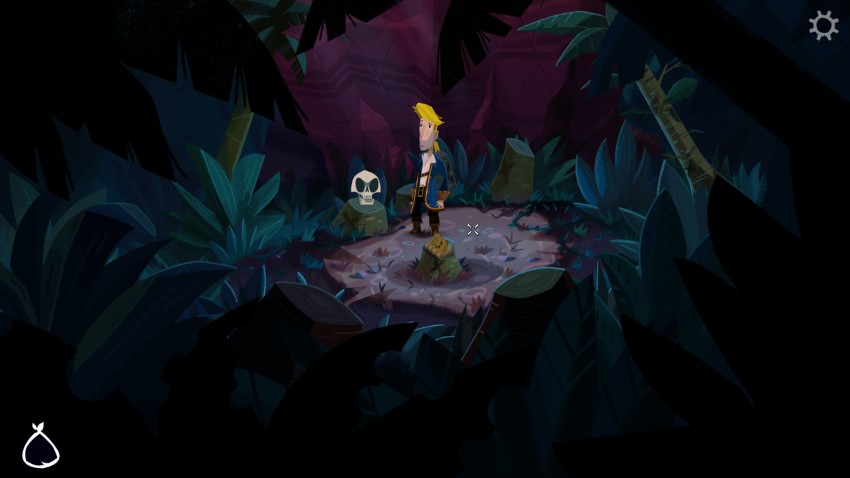
Since we can’t cover all the places in the game, can you talk about your favorite places and the ambiences you created for them?
AM: Terror Island was a fun one because it was the one where I really tried to stray away from the realistic approach that I took on the others.
I’m a nature recordist, so I do a lot of field recording. I have a big palette of natural sounds I can draw from…
I’m a nature recordist, so I do a lot of field recording. I have a big palette of natural sounds I can draw from – my own recordings and other libraries I’ve acquired over the years. Terror Island involved a lot of experimenting, finding interesting voices that could be in the background. I don’t do a lot of crazy filtering or processing for the design. I’m usually isolating out individual voices, like a few different kinds of frogs or birds in the background. I like to find the interesting things that can erupt out of the track, and then maybe do a little bit of pitch change. On Terror Island, there’s this burbling thing you’d hear periodically in the background and that’s actually just a bunch of slowed-down leopard frogs.
I’d find unique birds that could exist in the background – not playing them straight but playing them off in the distance with a bit of reverb and slowing or pitching them down because anything that felt like a happy songbird would not play into Terror Island so well.
…the nature recordist in me, couldn’t allow there to be this natural scene without birds in the background.
The eco-warrior in me, the nature recordist in me, couldn’t allow there to be this natural scene without birds in the background. If it’s nighttime, that’s one thing. Then there’d be some nighttime birds. But anything during the day had to have birds. It took a lot of experimentation to find things that could exist in that background and not sound out of place. There are more than just jungle birds in there. You’ll hear night hawks very quietly in the background and the occasional owl because it’s a dark place.
Because we’re on a narrative path, all these different areas in each zone lead from one to the next. Every time you switch to a new screen, there’s a new ambiance but it needs to sound like something that was in the scene just before to keep the player feeling like they’re still on the same island. As we’d move from one path on Terror Island into another path, we’d take out a few birds and add a few birds, maybe the frogs will play at a different rate or they’ll just be a bit quieter.
The birds transition from more traditional songbirds into birds that don’t necessarily sound happy.
As we work our way into the twisty path, farther out, there is a bit more happy life with fewer darker frogs and a bit more of the higher-pitched insects. As you work your way in, it does settle down in terms of the amount of life, but the insects get a little darker. The frogs get a little darker. The birds transition from more traditional songbirds into birds that don’t necessarily sound happy. And then as you work your way back out, it goes in reverse, obviously
So I had talked about avoiding wind or using too much wind a moment ago, but on Brr Muda that’s where I got to cut loose with the wind. Visually, there’s all this wind going on; it’s just constant snow and ice so it needs something that feels cold. But you can’t just have constant wind, otherwise, it’s like a white noise machine blasting in the player’s face.
…when you’re in an area that’s more open ice, there would also be a bit of skiddy stuff going across the ground…
There have to be swells; there have to be reactions to the wind. In FMOD, whenever I had individual wind events that were played, there are usually little bits of debris or reactions in the environment that would trigger right after those.
For instance, if there’s a gusty wind when you’re in an area that’s more open ice, there would also be a bit of skiddy stuff going across the ground – like little bits of ice that get scattered. It’s not terribly obvious. It doesn’t always play. It’s just enough so that it feels like the wind isn’t just hitting you in the face but it’s also affecting the world.
Get the full story behind the Monkey Island series:
The Making of Monkey Island (30th Anniversary Documentary)
I got to create that reaction the most when you’re in the town (the shanty area) on Brr Muda. I was able to work in more whistling winds or howling winds that sounded like they were pushing through buildings and having reactions in the building. So there was some creaky wood happening, or a shutter would flap back and forth. (It sounded far enough away that it didn’t feel like you had to look for one.) You have the sound of the wind and the buildings shaking as a result.
…if there was an owl or some darker voice, we’d play fewer insects or frogs immediately afterward as if they’re reacting to it by hiding from it.
OnTerror Island, that sort of thing would happen as well with the fauna on the islands, where certain birds or certain voices would only play right after others, just to give it a feeling that there’s something going on out there that you’re not in control of.
On Monkey Island, in the parks, there was none of that because it’s a happy place. It’s a nice place so the birds twitter and everything whistles and is happy. But, on Terror, if there was an owl or some darker voice, we’d play less insects or frogs immediately afterward as if they’re reacting to it by hiding from it. It’s not so noticeable but it contributed so much to everything by providing a subtle change and feel to the ambiences that hopefully worked to enhance the feel of the game.
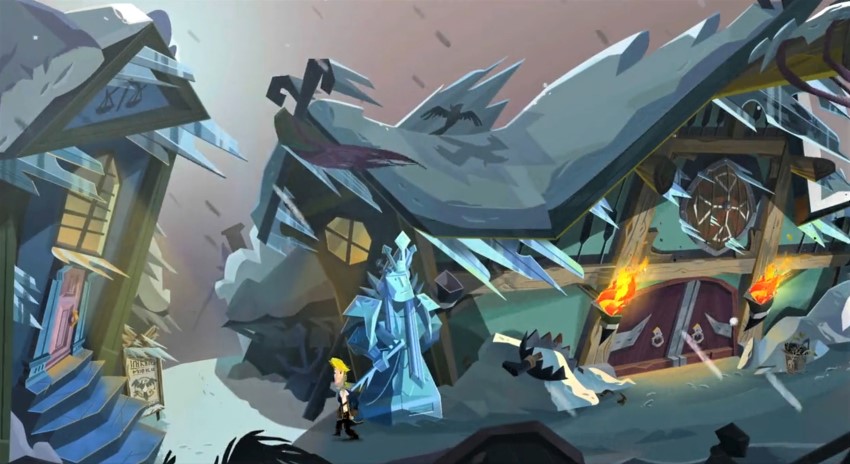
You briefly mentioned the ambience system and how you triggered the ambient sound design in FMOD. Can you elaborate on that?
AM: This is my first FMOD project. I’ve worked in games for a long time, and I’ve never had an FMOD project so it was a learning experience as to how to do it.
The triggering system was literally a single event. Each ambiance was on its own distinct parameter. Ron wrote a little script so that whatever a room would load, it would call a specific parameter for that room. And so an ambience event was basically this really long series of distinct events that would just crossfade back and forth between rooms. It was not a complex system at all.
Almost all of the ambient design was done 2D. We didn’t have any objects for the ambiences to tie into.
Almost all of the ambient design was done 2D. We didn’t have any objects for the ambiences to tie into. For instance, there are a couple of moments where you have a beach on one side and deep jungle on another side, and there’s this room that would scroll back and forth. Because there was nothing that I could play an ambient event on, I had Ron give me a continuous parameter from zero to one, where zero is all the way to the left side of the room, and one is all the way to the right side of the room. I’d control the pan for those locations. So it was not overly complex at all but good enough.
The ambient system – the actual system and how it was triggered – was pretty much set after my first couple of weeks. And then for me, it was just a matter of plugging everything in and building the individual ambiences up in FMOD. There are very few long-streaming tracks.
Almost everything was built out of smaller pieces and parts that I could just play at will.
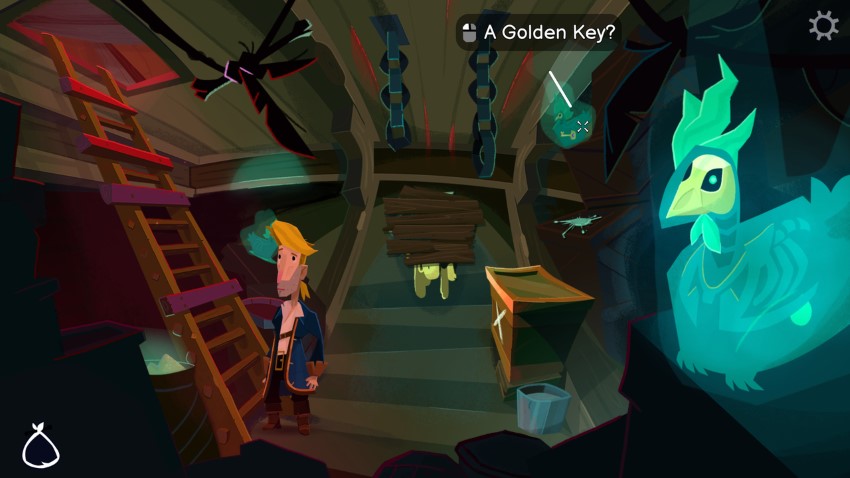
What were some fun things you got to do for the sound effects on LeChuck’s ship?
EK: I got to draw on my gross palette for that one, so that was really fun. A lot of the really gross stuff was created using hydrophone recordings. That was really fun to mess around with and they added a cool texture to a lot of things like the soups bubbling.
And, I mentioned earlier the dark magic palettes that are in there.
…the zombie characters were their own brand of fun and gross. I wanted to make sure that came across without making it too gross and distracting.
Also, the zombie characters were their own brand of fun and gross. I wanted to make sure that came across without making it too gross and distracting. I played with a lot of organic elements like fruit. For example, when Guybrush is a zombie and he changes into Gullet, I slapped a wet grapefruit a lot for his sounds. And there were a lot of cool geothermal libraries that I got on A Sound Effect that helped to beef those up.
LeChuck’s ship was a place with a lot of transitions too. And as Andy mentioned, it was a straightforward system. Between the scripts that the programmers were able to write and the AHDSRs (Attack-Hold-Decay-Sustain-Release envelopes) on a lot of the tracks, that took care of a lot of the transition smoothing, so thankfully I didn’t have to worry too much about that.
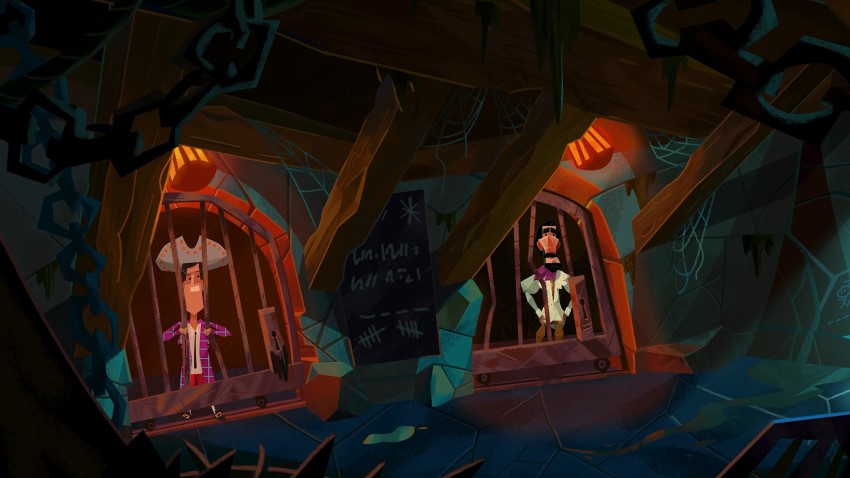
The sonic transitions between gameplay and the cut scenes are incredibly seamless. Music helps to bridge the sequences, of course, but what else were you able to do with sound to help the game feel seamless?
EK: We worked really hard to make sure the transitions were seamless. And if there were events that we knew were going to tie into one another, we made sure they could coexist in such a way that the events wouldn’t sound like they were overlapping, but instead were blending.
The use of organic palettes in those situations was really helpful because your brain wants those to finish in a natural way. You expect them to happen in a certain way, and hearing those resolve made that a lot smoother.
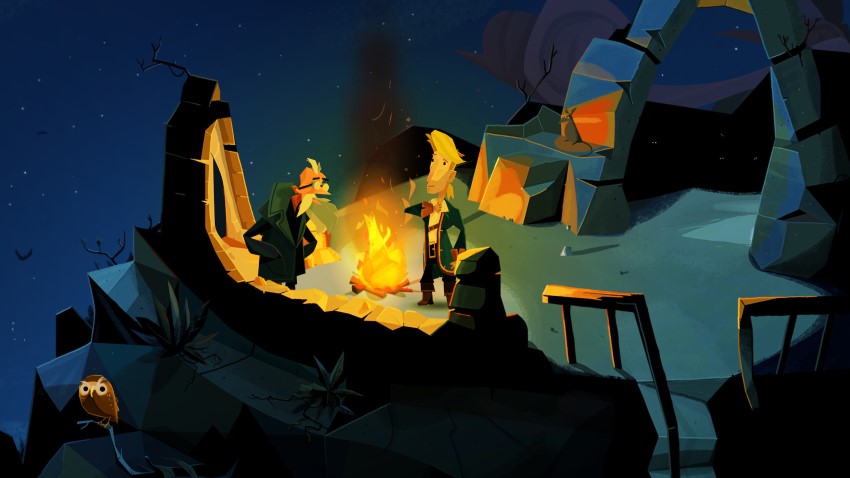
What were some of your technical challenges in terms of sound on Return to Monkey Island? The game was created using an engine called ‘Dinky’? I read that on Wikipedia. Ron Gilbert created it. Was that why you chose FMOD for audio implementation? Can you talk about this workflow?
AM: I had no interaction with Dinky. My entire interaction was through FMOD.
EK: Ron wanted to keep Dinky to the programmers. That’s their engine. We were living within FMOD. So once the list of new assets came in, the programmers would set up events in FMOD.
Using FMOD took a lot of time off of the programmers’ plates.
I had used FMOD on a previous project with Ron, between Thimbleweed Park and this game that dissolved, because audio implementation took a lot of time for the programmers to do during Thimbleweed Park – even if I was giving them instructions about how I wanted stuff to play back. Using FMOD took a lot of time off of the programmers’ plates. Also, the interface is a lot more accessible than Wwise. It was really easy for the programmers to look at the lay of the land and know what they had to do to set stuff up even without my help.
Pretty much everything we wanted to do…we were able to accomplish easily between Dinky and FMOD.
Ron was really gung-ho about FMOD. He dove deep into the FMOD forums to get his own questions answered and basically set me up with a test project right when I came on board, so I knew how he wanted stuff organized.
Pretty much everything we wanted to do – barring a few “pie in the sky” ambitions – we were able to accomplish easily between Dinky and FMOD. So that worked out really well.
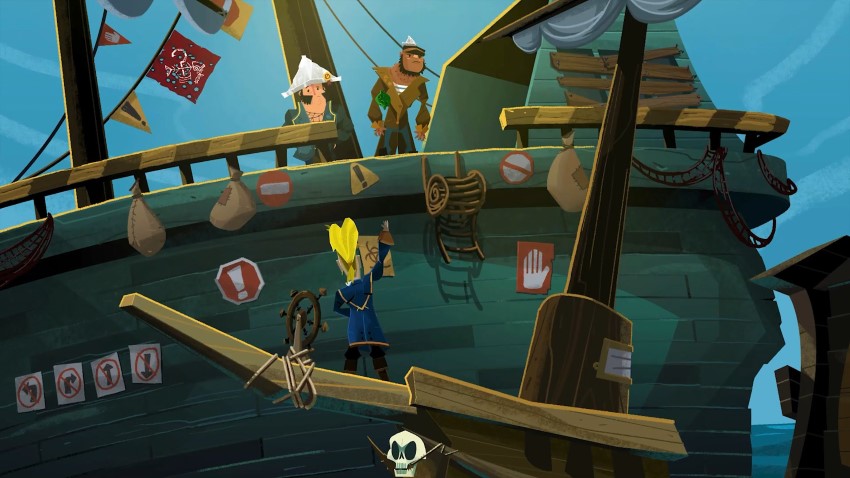
What were some of your creative challenges in terms of sound in the game?
EK: There are a lot of really cool, tiny animations that happen and memory is obviously a concern. Thankfully, it wasn’t a very big concern, but there were still so many things that were getting called up. We had to be able to run this on other platforms, like the Switch, so we had to keep in mind how much FMOD was doing at any given time. I had to pick my battles on what was getting pitch variation versus just volume or EQ automation. There were certain things that I would need to break down into individual layers in order to play out seamlessly during a cut scene.
I had to pick my battles on what was getting pitch variation versus just volume or EQ automation.
Also, footsteps and doors happen all the time, so I wanted to make sure that those would play back in a variable way but I also kept in mind that I couldn’t have a hundred variations of something. Occasionally, by splitting stuff up into stemmed tracks in FMOD, I would be able to call back to those in other events to save on memory.
There was also a big question of how to incorporate assets that we already had into events versus using more memory to make new events and how to keep those still sounding fresh and dynamic in the game. It was a meeting in the middle in terms of what we could reuse and save on memory and what absolutely couldn’t live without bespoke content and how to marry those two together.
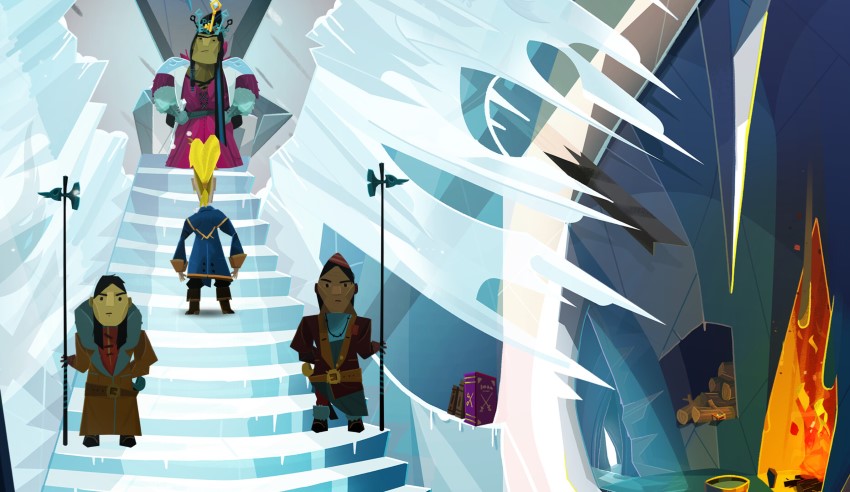
Were you using in-game processing, like adding reverb to the footsteps as Guybrush is walking through the caves?
EK: Spatialization was a big memory concern, so I had to factor that in as well. There are very few events that are actually spatialized within the game. I had to know that going in and figure out ways to communicate that in a more bare-bones way.
But there’s almost no processing in FMOD in terms of effects. It’s more stemming out different textures within the event and cross-fading those. We were leaning really heavily on the basic 3-band EQ in FMOD versus the pitch variation, and things like that.
We were using AHDSR to blend stuff in ways that I hadn’t really done before.
We were using AHDSR to blend stuff in ways that I hadn’t really done before.
It was fun to find solutions to those problems without having to pull out all the stops – to figure out how to work smarter and not harder. They all really paid off. It shows how dynamic of a tool FMOD is in terms of middleware. In the five or so years that I’ve been using it on projects, the updates and the flexibility that they continue to build into it are really mind-blowing. Between the project that dissolved with Ron and this one, the amount of features that have been fleshed out and put in is really impressive. So my hat’s off to them for sure.
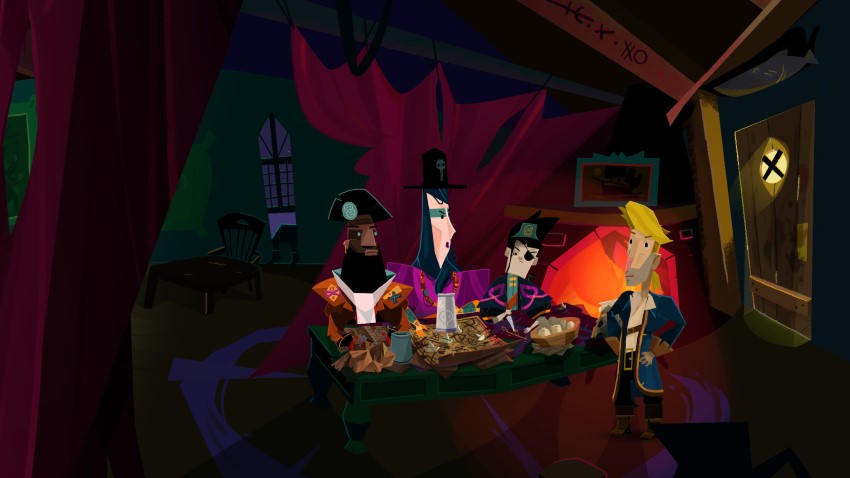
What are you most proud of in terms of your sound work on Return to Monkey Island?
AM: I’m most proud that I actually managed to make my way through it without dying in the process.
Honestly, it’s difficult to put a finger on. I’m most proud of the completion of it, having made our way through it and having the reaction be generally very positive. I’m a very poor judge of my own work. And I rely very much upon the people I work with and their reactions to know when I’m hitting a good bar for engaging the player. I always have my personal favorite things that I’m doing and very often those are tiny little details that nobody else will ever notice. And I will follow those little favorite details off into the desert if nobody else says, “Hey, maybe we should work on this thing over here.” And so seeing someone else’s reaction really helps me understand when I’ve had a good impact.
…being able to craft an environment that somebody else really engages with – even if it’s just a soothing environment to work in – makes me proud.
About two-thirds of the way through, I was having a meeting with Ron and he told me that he was really enjoying turning off all the sound except for the ambiences (sorry, Elise) and just working on something else, letting the ambiences play in the background. He was enjoying that as his work environment. That meant a lot to me, partly because I like creating an outdoor world for people to experience. We spend so much time in our stuffy little offices and we don’t interact with the outside world. So being able to craft an environment that somebody else really engages with – even if it’s just a soothing environment to work in – makes me proud.
There were a couple of online reviews from players and critics that had a similar line to them, that they just wanted to let the character stand still so they could have these insects in the background.
That’s the kind of thing that makes me feel fulfilled, and makes me most proud – to hear someone say that they just want to listen to it.
EK: My answer is two-fold. Of my own work, I’m really happy with the gross stuff because I had so much fun recording the source material for that. I’m really glad that it translated, and I’m really happy with how those turned out.
…the fun I had making those sounds carries over into the world and I’m really happy that Ron had fun with them, too.
Playing the game and listening to Dominic’s performance as Guybrush, I am really happy that it feels like everything came together in terms of feel and vibe. It’s a relaxed, goofy, and fun game. I’m really proud of how that translated.
As Andy mentioned, Ron’s a pretty quiet guy. When you can get his praise on something, it’s really valuable, even on the little things. Like, he mentioned that the UI sounds were really nice. I lived off of that for a week!
I’m really happy that the fun I had making those sounds carries over into the world and I’m really happy that Ron had fun with them, too. He’s the reason why all of us came together to work on this and so it’s just nice to know that he is enjoying it as well.
A big thanks to Elise Kates and Andy Martin for giving us a behind-the-scenes look at the sound of Return to Monkey Island and to Jennifer Walden for the interview!
 Tesla Model X 2015 electric full size crossover SUV sport utility vehicleKrampfstadt Studio65,00 $32,00 $51% OFF
Tesla Model X 2015 electric full size crossover SUV sport utility vehicleKrampfstadt Studio65,00 $32,00 $51% OFF


